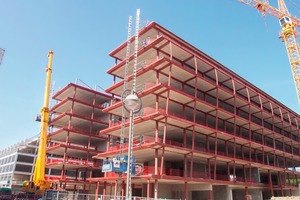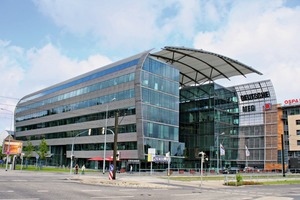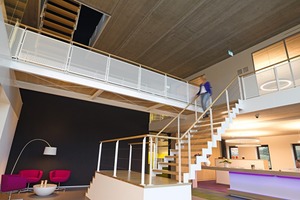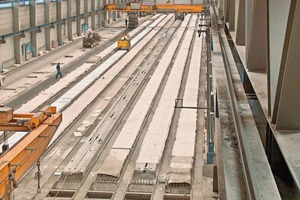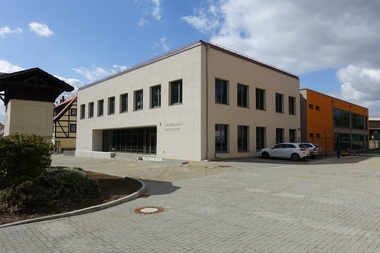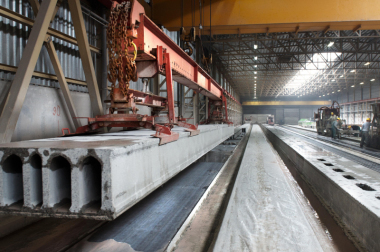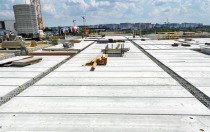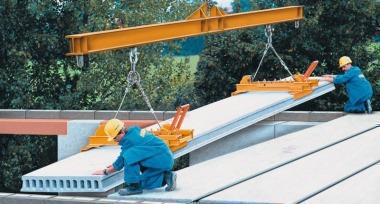Sustainable building with precast prestressed concrete floor slabs
In construction of new buildings, not only the cost effectiveness and the environmental impact should be considered, but also the sustainability of the buildings. Thanks to the availability of technical data sheets and Environmental Product Declarations (EPD), planners today can quickly and easily check individual quotations. In the final analysis, it is not the building products and materials themselves that decisively determine the sustainability of a building, but their use and impact during the course of a complete life cycle of a building. This is owing to the fact that a building should have the least possible negative effect on mankind and nature – starting with the time of erection, including utilization and demolition, and extending to disposal of the materials. The three critical assessment criteria for the sustainability of building are ecological/environmental compatibility, economic efficiency, and socio-cultural characteristics – for which adaptability and durability play a key role. In this context, a flexible loadbearing structure is of special significance, to ensure the maximum possible adaptability in terms of space requirement and changing user demands.
The following questions are especially appropriate in evaluating the adaptability of loadbearing structural designs and, in turn, their sustainability: Do the floor plans allow construction without loadbearing interior walls: i.e., can the rooms be freely divided? Do the design approaches allow for other types of use? Are the heights between floors sufficient to enable other types of uses? Is the building shell separate from the loadbearing structure so that the façades can be exchanged?
Sustainability – checks
In a research project entitled “Sustainable building with concrete,” conducted by the German Committee for Reinforced Concrete (DAfStb), three cases for a utilization period of 100 years were examined, as based on an applicable model building with flexible loadbearing structure, under the following conditions: 20 years’ use as cellular office, 20 years reutilization as open-plan office landscape, and 60 years of new use as residential building with three different floor plans – compared with conventional buildings that have to be replaced with newbuilds after 40 years.
About 6 % added costs are incurred for erecting a building with a flexible loadbearing structure, compared with a building without such a structure. However, during the period of utilization, life-cycle costs with flexible loadbearing structures were less by 16 % and energy consumption was less by 7 % – and CO2 emission lower by 21 %. The amount of demolition waste and, in turn, of raw materials was lower by 21 %.
Building with flexible loadbearing structure
The “Deutsche Med” health center in Rostock, Germany (Fig. 1) was designed by the architect Helmut Jahn from Chicago with two six-story building structures (Fig. 2). It features a curved glass skin (Fig. 3), with utilization of precast prestressed concrete floor slabs to enable a free design of the floor plan. After being quickly constructed, the building was completed in July of 2004. It is a model example of anticipatory planning of the supporting structure. With more than 17,300 m² of precast prestressed concrete floor slabs (Fig. 4) and with column-free spans of 11.40 m (Fig. 5), no loadbearing elements were required – except for the stiffening staircases (Fig. 6) and a small number of stiffening walls – that would in any way restrict the use of interior rooms. All stories can therefore be subdivided at will, and the interior walls can be removed or rearranged for repurposing.
Since the façade is decoupled from the supporting structure (see Fig. 2), it can be readily exchanged if required – an example that only buildings with a maximum degree of adaptability for new later uses are fit for the future and thus sustainable. This example shows that, for implementing flexible supporting structures with long-span story systems, sufficient story heights and load assumptions as well as decoupled façades represent absolute prerequisites.
Prestressed hollowcore concrete planks
The fully precast floors are completely prefabricated in the plant and only the bond beam and the joints between the slabs must be cast at the construction site (e.g., Brespa-Decken). With prestressed hollowcore concrete planks, a fully precast floor slab, the possibilities for prefabrication are optimized: apart from higher quality assurance due to fabrication in the plant, the loadbearing capacity is much higher, at a much lower self-weight.
Prestressed hollowcore planks are cast on steel beds of 100-m length and 1.20-m width (see Fig. 4) in thicknesses from 15 to 40 cm with pretensioned prestressing steel wires and cut to the required lengths after hardening (see Fig. 5). In this way, dimensionally stable cross-sections with large void ratios are manufactured in the precast plant independently of weather conditions and are erected at the construction site within very short time (up to 500 m2/day). Their supports must be smooth and level and sufficiently hardened. The prestressed concrete slabs are advantageous for use in construction projects with interior spaces that feature large unsupported spans. Prestressed concrete floors can span 16 m without intermediate supports under 3.0 kN/m² useful load. Prestressed hollowcore planks, compared to solid concrete floor slabs, are resource-saving products: 50 % less concrete and 75 % less steel. This 50 % saving in load achieved with hollowcore planks has a cost-savings effect on all other construction components, down to the foundations. Prestressed-concrete hollowcore planks (Fig. 7) can be used in nearly all areas of building construction. An essential prerequisite here is the availability of final construction drawings at an early project stage – despite deadline and cost pressure.
Text: Dipl.-Ing. Gunther Brux

